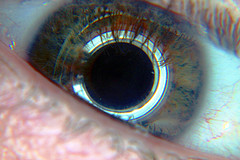 All this talk about augmented reality is all well and good, but wandering around holding up a little rectangular gadget to see things through is hardly an elegant science fictional solution, now is it?
All this talk about augmented reality is all well and good, but wandering around holding up a little rectangular gadget to see things through is hardly an elegant science fictional solution, now is it?
As a fully paid-up cyberpunk, I want everything as tightly integrated to the meat as possible – so I want my AR operating no further from me than the surface of my eyeballs. Luckily I shouldn’t have too long to wait – at least not if Babak Parviz of the University of Washington has the successes he hopes for with his augmented reality contact lens concept:
Conventional contact lenses are polymers formed in specific shapes to correct faulty vision. To turn such a lens into a functional system, we integrate control circuits, communication circuits, and miniature antennas into the lens using custom-built optoelectronic components. Those components will eventually include hundreds of LEDs, which will form images in front of the eye, such as words, charts, and photographs. Much of the hardware is semitransparent so that wearers can navigate their surroundings without crashing into them or becoming disoriented. In all likelihood, a separate, portable device will relay displayable information to the lens’s control circuit, which will operate the optoelectronics in the lens.
These lenses don’t need to be very complex to be useful. Even a lens with a single pixel could aid people with impaired hearing or be incorporated as an indicator into computer games. With more colors and resolution, the repertoire could be expanded to include displaying text, translating speech into captions in real time, or offering visual cues from a navigation system. With basic image processing and Internet access, a contact-lens display could unlock whole new worlds of visual information, unfettered by the constraints of a physical display.
Parviz has a long old article there, and for those with a more technical bent it gives an insight into the way the contacts will actually work… though he’s canny enough not to put a solid date on the technology becoming available. [via New York Times; image by pasukaru76]
I wonder if he needs any test subjects?